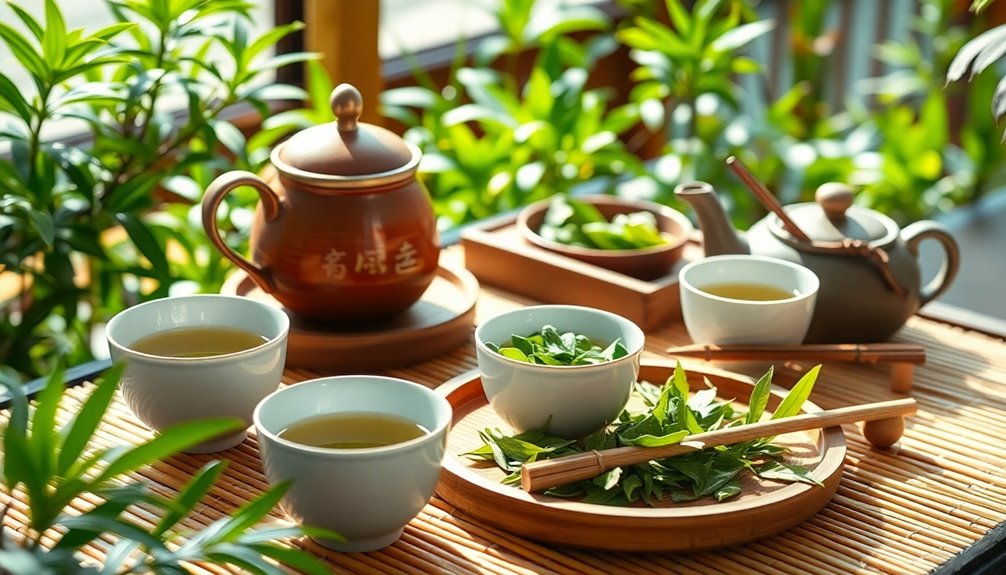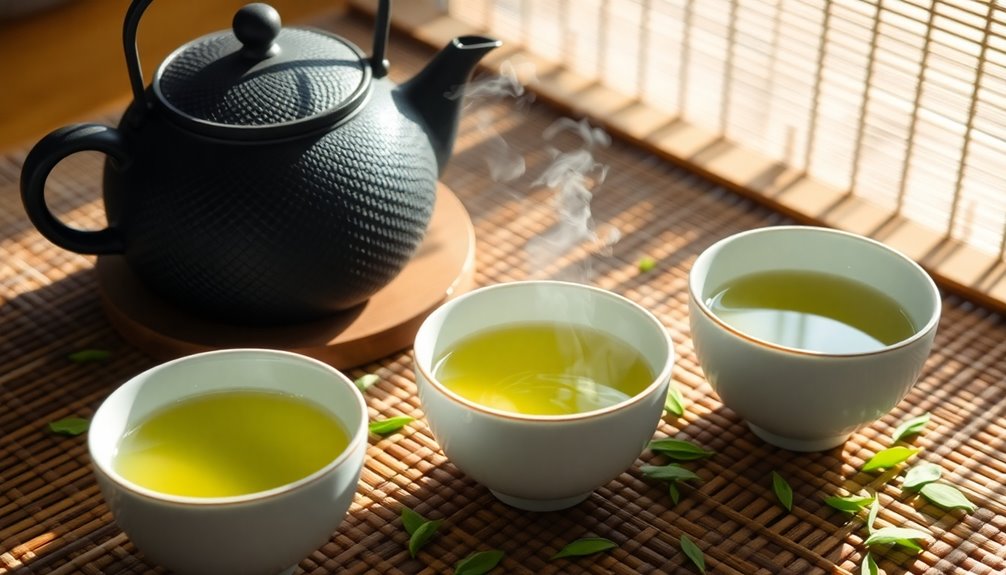Exploring the art of sencha brewing is a joyful adventure for the whole family! Start by using filtered water, heated to 160°F to 180°F. Remember, you want to steep your sencha for just 1 to 2 minutes—this keeps it tasty and avoids bitterness. Use 1 teaspoon of tea for every 6-8 ounces of water. Using a traditional kyusu adds extra fun! You'll discover beautiful regional flavors and quality differences too. As you brew together, you'll create lasting memories and share the warm spirit of this amazing tea. Stick around, and you'll uncover even more delightful tips!
Key Takeaways
- Brew sencha at a temperature between 70°C (160°F) and 80°C (180°F) to preserve its delicate flavors and prevent bitterness.
- Steep sencha for 1 to 2 minutes, adjusting time to taste preferences for optimal flavor extraction.
- Utilize filtered water to enhance the tea's flavor profile and ensure a refreshing cup.
- Employ traditional teaware, like a kyusu, to elevate the brewing experience and connect with Japanese culture.
- Explore regional variations, such as Shizuoka and Uji, to discover unique flavor profiles and cultivation practices of sencha.
Introduction

If you're looking to explore the world of Japanese tea, sencha is a perfect starting point. This delightful tea is loved for its fresh, grassy flavor and beautiful green color. When you brew sencha, you open up a whole new experience!
Here are some fun tips to get the best out of your sencha brewing:
- Temperature: Aim for about 70°C (160°F to 180°F) to keep that fresh taste.
- Steeping Time: Let it steep for just 1 to 2 minutes. This short time helps the flavors shine without getting too bitter.
- Tea-to-Water Ratio: Use 1 teaspoon of sencha for every 6-8 ounces (about 200ml) of water. This balance makes the tea taste just right!
- Water Quality: Filtered water enhances the flavor, making each sip even better.
- Teaware: Using a traditional kyusu can make your brewing feel even more special.
With these tips, you'll be brewing sencha like a pro in no time!
Traditional Japanese Tea Ceremonies

While immersing yourself in the beauty of Japanese culture, you can't overlook the significance of traditional tea ceremonies, known as "Chanoyu." These ceremonies embody harmony, respect, purity, and tranquility, showcasing the essential role tea plays in Japanese life.
During a tea ceremony, you might see the elegant preparation of sencha green tea, which requires skillful brewing techniques. Here are a few key elements that make these ceremonies special:
- Utensils: You'll find unique tools like the tea whisk (chasen) and tea bowl (chawan) that contribute to the experience.
- Atmosphere: The setting is often a peaceful tatami-matted room or a serene garden, designed to calm the spirit.
- Mindfulness: Participants are encouraged to engage fully with the process, creating a connection with nature and each other.
As you sip the perfectly brewed sencha tea, you'll feel the joy and warmth of sharing this special moment.
Traditional Japanese tea ceremonies offer more than just a drink; they provide a delightful experience filled with beauty, respect, and the rich culture of Japan.
Optimal Water Temperature Range

Brewing the perfect cup of sencha green tea hinges on the right water temperature, which plays a significant role in unlocking its delicate flavors. The optimal water temperature for brewing sencha is between 160°F to 180°F (70°C to 80°C). This range helps keep the tea's natural sweetness and umami characteristics front and center while preventing that bitter taste we want to avoid.
To make the most delicious cup, you might need to adjust the temperature a little. Lighter steamed varieties taste best at the lower end of the scale, while deeper steamed types can handle the higher temperatures. Remember, using boiling water is a no-go! It can over-extract the tea, leaving you with an unpleasantly bitter flavor.
For the best results, a thermometer is your trusty sidekick. It'll help you hit that ideal water temperature every time, ensuring your brews are always consistent and enjoyable.
With proper temperature control, you'll be amazed at how balanced and delightful your sencha can be! So grab your kettle, set the temperature, and get ready to enjoy a cup of joy with family and friends!
Regional Variations in Sencha

Sencha's unique flavor profiles are deeply influenced by the regions of Japan where it's grown. Each area has its special touch, making every cup a delightful surprise!
- Shizuoka: This region is famous for the Yabukita cultivar, known for its balanced flavor. It's the most popular type of sencha, and you'll love its smooth taste!
- Uji: Known for high-quality tea, Uji offers sencha with a rich umami taste and a delicate sweetness. They use traditional cultivation methods, which adds to its charm.
- Kagoshima: Located in the south, Kagoshima's sencha has bolder, more robust flavors. The volcanic soil and warmer climate help the leaves grow quickly, creating a vibrant taste.
These regional variations aren't just about where the tea comes from; they also include different steaming techniques. Each technique changes the tea's aroma and overall flavor, making it even more exciting to explore.
Quality Variability Among Producers

When exploring sencha, you'll quickly notice that quality can vary widely among producers. This difference often comes from how they grow and process their sencha leaves. For example, traditional tea makers in Japan use careful techniques that enhance flavor, while modern machines focus on speed.
Here are some key points about quality variability:
- Cultivation practices: The type of tea plants and the garden's environment can change the taste of sencha.
- Harvest timing: You'll find that the first harvest, known as shincha, is the freshest and most prized.
- Steaming duration: The way sencha is steamed—lightly or deeply—affects how it tastes. Light steaming keeps it fresh, while deep steaming makes it smoother.
- Producer reputation: Well-known producers often stick to high standards, making their sencha more reliable in quality.
Practical Applications

Enjoying a perfect cup of sencha hinges on understanding practical applications that enhance your brewing experience. Here's how you can get the best flavor from your tea!
- Tea-to-Water Ratio: Use about 7-8 grams of sencha leaves for every 200ml of water. This balance helps create a delightful flavor.
- Water Temperature: Aim for a water temperature of around 175°F (80°C). This keeps the flavors bright and prevents bitterness.
For later infusions, you can increase the temperature to 80-90°C to explore more flavors.
- Steeping Time: Steep the leaves for about one minute to extract a rich flavor. If you prefer a stronger cup, feel free to adjust the steeping time to your taste.
- Fine-Mesh Filter: Using a fine-mesh filter is a smart way to keep those delicate leaves in check and enhance your overall experience.
Frequently Asked Questions
What Does Sencha Tea Do to Your Body?
Sencha tea boosts your immune system, helps lower cholesterol, and promotes relaxation. Its antioxidants combat oxidative stress, while caffeine gives you a mild energy lift. Plus, it may aid in weight management and enhance cognitive performance.
How to Brew Perfect Sencha?
To brew perfect sencha, use 7-8 grams of leaves per 200ml water heated to 175°F. Steep for one minute, adjusting for taste. For more infusions, raise temperature and tweak steep times for varied flavors.
How Many Times Can Sencha Be Brewed?
You can brew Sencha leaves multiple times, typically up to three or four. Each infusion reveals unique flavors, so adjust the water temperature and steeping time for the best taste in subsequent brews.
What Is the Difference Between Houjicha and Sencha?
Houjicha's roasted, caramel-like flavor contrasts with Sencha's fresh, grassy notes. You'll notice Houjicha's brown hue and lower caffeine, while Sencha's vibrant green offers higher antioxidants and a more delicate taste. Enjoy both for unique experiences!
Conclusion
Now that you've explored the delightful world of sencha brewing, why not gather your family for a cozy tea time? With the right water temperature and fresh leaves, you can create a tasty treat everyone will enjoy. Remember, each sip tells a story of tradition and love. So, brew up some happiness, share the joy, and make wonderful memories together. Cheers to your next sencha adventure—it's sure to be a fun and flavorful experience!










